Copyright © 1997, Richard W. Pogge., All Rights Reserved.
This is the hypertext version of a public lecture given on 1997 June 12 at the Perkins Observatory in Delaware, Ohio, as part of the 1997 New Vistas in Astronomy lecture series.
The life cycle of a star, from birth in a dense interstellar cloud to its final end, is a process that lasts anywhere from a few Million years for the most massive stars to many Billions of years for stars like the Sun.
How, then, can we hope to understand a Billion-year process if we astronomers have only been studying the stars with modern techniques for the last 100 years?
A simple analogy illustrates how we do this. Suppose you are a biologist wanting to understand the life cycle of an oak tree. Oak trees can live to be a few hundred years old, yet on an afternoon hike in a forest, you can piece together the sequence in outline not just for oaks, but for all other species of trees in the forest. A little extra fieldwork visiting forests of different ages (old growth and young new growth near abandoned farms), and you should be able to work out all of the relevant timescales. After more advanced work on the detailed biology of individual trees would allow you to discern the basic principles that govern the growth and development, you could relate these to your observations of forests, and develop a comprehensive picture of the life cycle of oaks.
So too with stars. We can observe clusters of stars all born at about the same time to get an idea of how stars of the same ages but different masses appear. By observing many different star clusters, each with a different age we have pieced together how the clusters age and work out the timescales of "stellar evolution". By studying individual stars, and working out the detailed physics, we have put together a comprehensive physical theory of the appearance and evolution of stars.
Coming to an understanding of the process of stellar evolution is one of the great triumphs of 20th century astrophysics. We are now sufficiently confident of our results that an apparent discrepancy between the ages of the oldest stars in the Galaxy and the estimated age of the Universe is thought by many to signal weaknesses in our understanding of the evolution of the Universe rather than problems with the theory of stellar evolution. Not all astronomers would agree with that, but I would argue that the physics of stellar evolution is probably on firmer theoretical and observational ground than the physics of the cosmos.
The study of stellar evolution is rich and detailed. In my Astronomy 162 course at Ohio State, we take about 4 weeks to cover all the material. In this lecture, I want to illustrate the highlights of what we know about the evolution of stars in general by highlighting the evolution of a particular star near and dear to all of us: The Sun.
To speak more easily of the timescales and sizes involved, I introduce three relatively unfamiliar units widely used by astronomers:
I will be using metric units throughout.
The sun formed out of a dark cloud of cold molecular Hydrogen gas and dust.
Overall, the formation process for a star the mass of the Sun takes about 50 Myr.
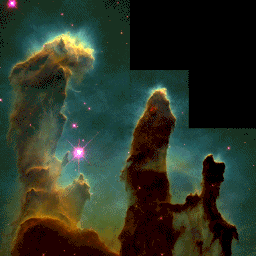 Credit: NASA & AURA/Space Telescope Science Institute
Credit: NASA & AURA/Space Telescope Science Institute
Molecular gas cloud fragments in the Eagle Nebula (M16) star-formation complex. This spectacular Hubble Space Telescope image shows regions of molecular gas and dust, most with faint embedded protostars, being illuminated by a hot young star off the edge of this field of view. The individual lumps breaking off the ends of these "elephant trunks" of gas are comparable in size and mass to the pre-stellar clumps out of which stars like the Sun might form. In this region, however, it appears that many of these clumps are being evaporated by the hot UV radiation from the nearby hot stars before they have a chance to form into low-mass stars.
The proto-Sun slowly contracted while embedded deep within its birth cloud.
At this stage it was only visible as a bright infrared source, since only infrared light can penetrate the surrounding gas and dust clouds.
For example, below are two views of a present-day stellar nursery, the Orion Nebula.
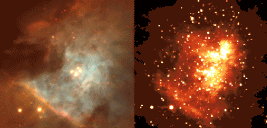 Credit: OSU Astronomy Department
Credit: OSU Astronomy Department
The view on the left is what is seen in visible light. On the right is the same view at infrared wavelengths. Notice how only a handful of faint red stars are seen at visible wavelengths, while in the infrared, we can peer through the dusty Orion molecular cloud and see the rich cluster of young stars recently formed deep within. The quartet of bright stars in the center of the nebula, known collectively as the "Trapezium", will eventually blow away much of the surrounding gas and dust. When that happens in a million years or so, the rich cluster will be visible in the night sky of earth.
A disk of material formed around the proto-Sun, out of which the planets were formed.
Collapse of the proto-Sun continued until the core temperature reached 15 Million K:
At this point:
The material in the equatorial disk steadily coagulated into the planets.
After a few million years, the remaining gas was blow away, and the young Sun emerged as a star shining in the night sky, surrounded by its retinue of 9 planets. The infant solar system was still filled with debris that would take roughly another billion or so years to clear away.
Hydrogen ignition occurred 4.5 Gyr ago.
There is sufficient Hydrogen available in the central core of the Sun to sustain nuclear fusion at a fairly constant rate for almost 11 Gyr.
The young Sun started out with slightly different properties than we see today:
There is some evidence in the fossil record of the different properties of the young Sun, as reflected in how sunlight affected life on Earth. This evidence is still hard to read precisely, but it largely confirms in outline the fact that Sun has steadily, if slowly, evolved over the life of the Earth.
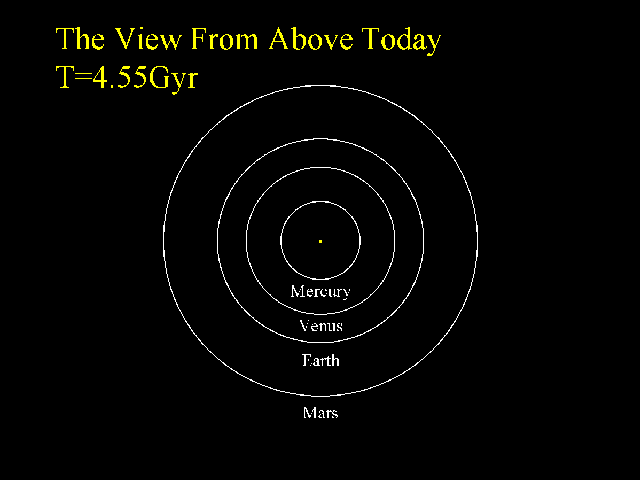
The Sun today is a middle-aged star with the following properties:
|
Age: |
4.55 Billion Years |
|
Mass: |
1 Msun = 1.99x1033 g |
|
Radius: |
1 Rsun = 700,000 km |
|
Luminosity: |
1 Lsun = 3.83x1026 Watts |
|
Temperature: |
5779 K |
|
Fuel Supply: |
50% of the core Hydrogen has been consumed. |
The values of the mass, radius, and luminosity (total power output) of the Sun are so large that we will use the current Sun as our basis of comparison when discussing its subsequent evolution.
The Sun evolves very slowly over this time as it consumes Hydrogen in its core:
Otherwise, very little else happens, so far as the Sun is concerned. For the planets, however, the change in total solar radiation has an impact. For one particular planet, the impact is quite dramatic.
T=5.6 Gyr (1.1 Gyr from today):
The Earth's atmosphere will dry out as water vapor is lost to space. Such a situation will probably spell the end of large surface life on Earth. Some types of marine life and simpler life forms will likely survive in the oceans and localized pools of water.
T=8 Gyr (3.5 Gyr from today):
The oceans will evaporate into space, and conditions on the Earth will be like those on Venus today. Such conditions will probably mean the end of all forms of terrestrial life.
At an age of about 10.9 Gyr:
When this occurs, the sun will:
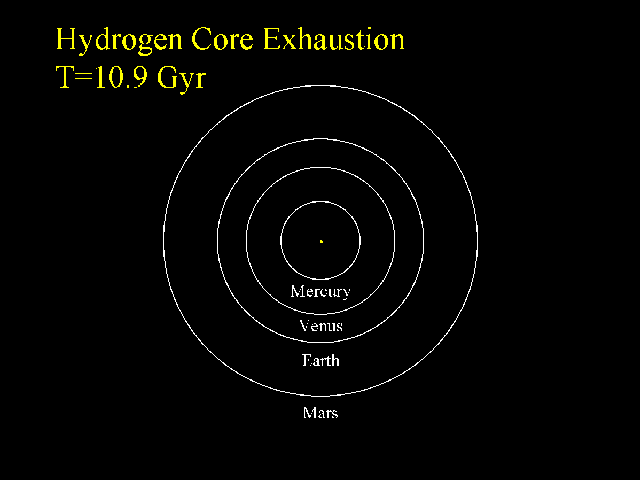
Slow evolution over the next 700 Myr:
At T=11.6 Gyr, the sun becomes a Subgiant star.
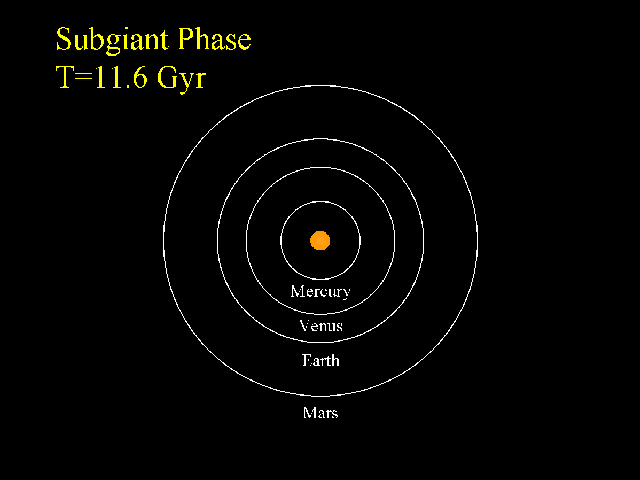
T=11.6 Gyr:
Onset of a 600 Myr period of relatively rapid growth in size.
T=12.15 Gyr:
Strong stellar wind begins to kick in, over the next few Myr the Sun will shed some 28% of its total mass by losing the outer parts of its envelope to the wind.
Lower mass of the Sun results in less central gravity in the Solar System, and the planets slowly move outwards in their orbit in response:
T=12.233 Gyr:
This growth of the Sun (with accompanying mass loss from a strong stellar wind) continues as the Sun evolves into a Red Giant Star:
The bloated outer atmosphere of the Sun engulfs Mercury, destroying it.
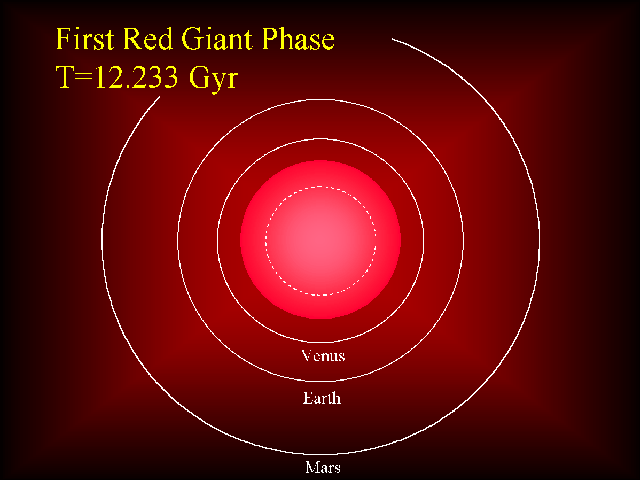
The dashed line shows the present orbit of Mercury.
T=12.233 Gyr:
At the same time that the Sun reaches maximum size as a Red Giant, the Helium core has reached at temperature of about 100 Million degrees. When this happens, Helium fusion ignites in the core, providing a new source of central energy for the Sun:
This new source of nuclear energy has the effect of reversing the previous growth of the Sun.
This results in the Sun rapidly rearranging its internal structure, shrinking in size as it does over a roughly 1 Myr period.
T=12.234 Gyr:
The Sun, with a new source of nuclear energy, settles down for a period of stability as a Helium Burning Star:
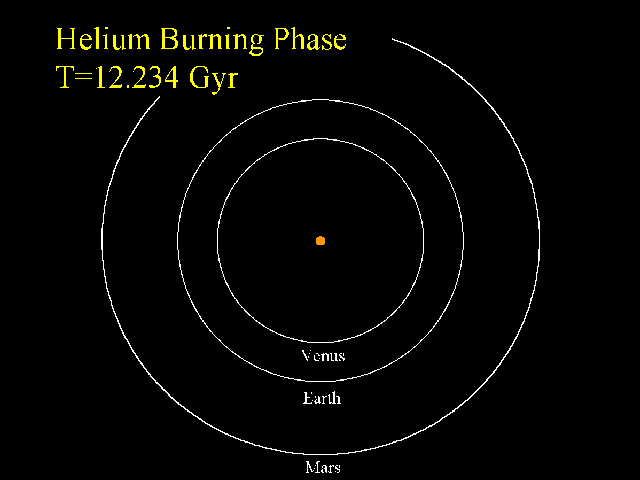
Sun now settles in for a 110 Myr period of relative stability, shining fairly steadily as a Helium-burning star.
The strong stellar wind of the Red Giant phase tapers off during this period.
The Sun burns He to C&O in its core for 110 Myr. As it consumes Helium, C & O ash begins to collect in the core as before, forcing small changes to the Sun's internal structure. The accommodation of this new structure leads to outward changes in the Sun.
As a result, the Sun begins to slowly grow in size again:
T=12.344 Gyr
The Sun's core finally runs out of Helium:
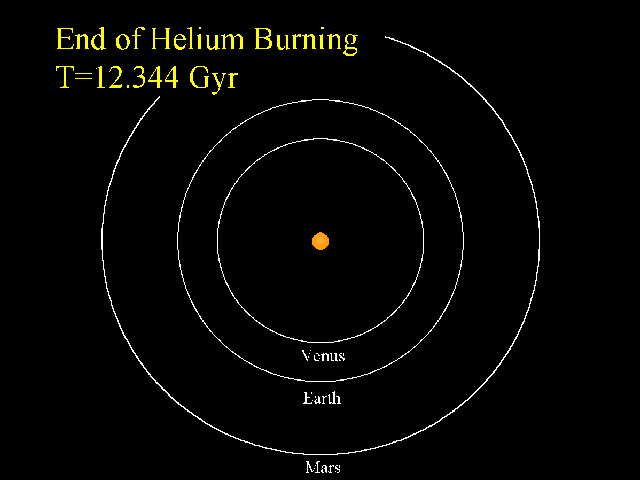
This leads to the onset of a second rapid growth phase like after the Hydrogen core was exhausted. Only this time, the growth is much more rapid, requiring 20 Million instead of 600 Million years.
Unlike the last time, however, the collapsing C-O core will not get hot enough for Carbon fusion to ignite. This requires a temperature of 600 Million degrees. The Sun is too small in mass to get a core this hot. It appears to happen only in stars of 4 times the mass of the Sun or more.
This starts to spell the beginning of the end for the Sun. With no more sources of nuclear energy to tap, the Sun will reach a crisis.
T=12.345 Gyr
The Sun experiences very rapid growth over 20 Million years:
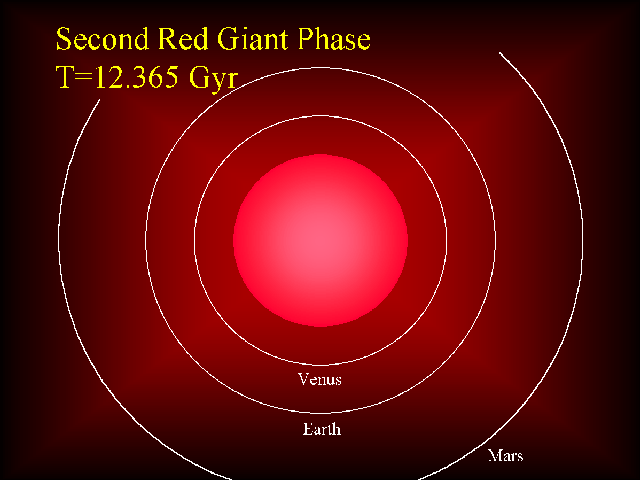
As it grows, the stellar wind gets stronger as the outer portions of the Sun's atmosphere begin to evaporate away into space.
Mass loss proceeds rapidly during the second Giant Branch phase.
Eventually, almost 46% of the Sunís original mass will be lost.
The remaining planets move further outward in response to the reduced central mass of the Sun:
This is just enough to keep them from being engulfed by the swelling Sun.
T=12.365 Gyr:
Deep inside the Sun, the thin Helium burning shell riding on top of the inert C-O ash core becomes unstable. This instability takes the form of rapid swings in the nuclear reaction rate which is phenomenally sensitive to small changes in the temperature of the gas (basically, the nuclear fusion rate goes like Temperature to the 40th power!)
Every 100,000 years, the Sun pulses violently:
Models predict a total of 4 pulses will occur over this period, each ejecting more mass than the last one.

The 4th and Final pulse blows off the last of the envelope over about 100,000 years.
The hot inner C-O core of the Sun is unveiled:
UV photons from the hot naked core ionize and illuminate the ejected envelope.
This gas lights up as a spectacular Planetary Nebula
The glowing envelope of gas expands and disperses in 10,000 years.
Thus the last reward of the Sun for all of the other tribulations at the end of its relatively long life is to enjoy a last, brief flowering as one of the most beautiful and colorful objects in the heavens.
 Credit: OSU Astronomy Department
Credit: OSU Astronomy Department
Computer-enhanced color image of the Ring Nebula in Lyra, a Planetary Nebula puffed off the central faint blue star seen in the middle of the ring.
The central C-O core of the Sun, now stripped of its envelope and having a mass of only 0.54 Msun, evolves into a slowly cooling White Dwarf the size of Earth.
Since it has no more fusion source of its own, it shines only by the leftover heat from its earlier, more exciting days as a hot stellar core.
As it cools off slowly over time, it fades in brightness, finally becoming as cold and dark as empty space around it.
Because a white dwarf is so tiny, it radiates very inefficiently, so it takes Trillions of years for it to cool off completely. Because we think the Universe is only about 15 Billion years old, it is not yet old enough for the first generation of white dwarfs to have cooled off.
Remaining planets settle into their final orbits:

And so on proportionally for all of the others. Since the Sun has lost all of the mass it can, this will represent the final configuration of the Solar System for the future.
|
Hydrogen Burning Phase: |
11 Gyr |
|
First Red Giant Phase: |
1.3 Gyr |
|
Helium Burning Phase: |
100 Myr |
|
Second Red Giant Phase: |
20 Myr |
|
Unstable Pulsation Phase: |
400,000 yr |
|
Planetary Nebula Phase: |
10,000 yr |
|
White Dwarf Phase: |
forever... |
Copyright © Richard W. Pogge, All Rights Reserved.